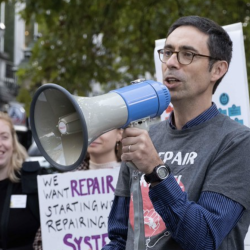Budapest Zoo & Botanical Garden / Fovárosi Állat- és Növénykert
https://www.zoobudapest.comIntroduction
Through his transformation of the National Zoo of Budapest, Miklos Persanyi is mobilizing support for environmentalism by cultivating public interest in and support of animals and their habitats. He is reinventing the role of the zoo to include a range of educational programs aimed at heightening public awareness of pressing ecological and cultural issues in Hungary and throughout Europe.
The New Idea
Miklos feels strongly that as zoos attract millions of visitors annually, they provide an excellent, although largely untapped, resource for furthering the aims of environmental awareness and preservation. Since his appointment as the Director of the National Zoo of Budapest in 1994, he has introduced innovative educational programs designed to facilitate involvement in broad environmental concerns across a range of groups—businesses, schools, families, and scientists. Under his direction, the Zoo has become a training facility for school children and adults alike, and its programs are reaching sectors of the population that would otherwise have little or no exposure to pressing issues resulting from sustained environmental degradation.
Through interactive educational programs, including daily classes and presentations and controlled animal feeding, the Zoo provides an outdoor classroom for thousands of school children and visitors. Miklos’ programs have significantly bolstered the Zoo’s visibility and fund-raising capability in Hungary and beyond. During his tenure as the Director, attendance has jumped from 100,000 to over 1 million visitors annually. The cost of entrance has also risen by 100 percent but Miklos has devised a system whereby families, children, the disabled, etc. receive discounts on this fee. In 1994, fewer than 1,000 children aged 3 to 18 visited the Zoo; now, five years later, over 25,000 students flock to the Zoo to learn about animals, their habitats, and their needs—both in confinement and in the wild. In addition to advancing environmental awareness through the Zoo’s new programs, Miklos is cultivating civic involvement and volunteerism in support of the century-old Zoo as a prized cultural institution.
The Problem
The effects of industrialization in Central Europe have proven devastating to Hungary and its neighbors. Pollution, acid rain, and deforestation have contributed to a host of environmental hazards, culminating in poor air and water quality, decline in species diversity and population size, and destruction of natural habitat throughout much of the region. With little attention from the government or from policymakers during the former Communist era, environmental problems worsened and now rank among the most critical in the region. Without significant advocacy in the coming years, these problems will threaten the viability not only of the region’s flora and fauna, but of the health and safety of its human population as well.
With little support for environmental protection, the implementation of necessary municipal programs, such as recycling, is incomplete at best. Even now, a decade after the introduction of democracy in Hungary, conservation efforts are few and the programs that do exist suffer from inadequate funds and support. Government money, which is already scarce, is more frequently channeled into “elite” cultural institutions, such as the National Opera, than in to necessary environmental education and conservation efforts.
In the former Communist Hungary, the institution of the zoo in no way facilitated environmental and social improvement. Many zoos of that era were an abomination to animal rights, instilling in visitors a mockery of animals rather than an increased respect for them as integral components of what should be a carefully-balanced ecosystem. Living conditions for zoo animals were often cramped and dirty, and animals suffered from insufficient food and poor sanitation. Even after the disintegration of Communism in Central Europe, zoos continued to face problems of disorganization, resource scarcity, and inhumane practices toward animals. No clear model existed to facilitate zoo reform or to transform zoos into sustainable centers for increased environmental and cultural awareness. While several Hungarian zoos attempted some level of restructuring, their approach proved too narrow. Instead of developing programs to engage and educate a broad spectrum of visitors, these zoos ultimately proved ineffective in attracting large numbers of visitors and become self-sustaining.
The Strategy
When Miklos assumed the Zoo’s Directorship in 1994, he understood that a pivotal first step in mobilizing support for environmental protection involves educating a social sector that, in many parts of Central Europe, is largely unaware of basic ecological principles and environmental protection measures. To increase the Zoo’s visibility and impact, he introduced a range of programs—including interactive exhibits—to attract families, children, teachers, and school groups. The Zoo now hosts visitors for 6 to 8 daily lectures, and schools use its facilities to augment in-class work with hands-on learning. During the summer months, 160 high school students work at the Zoo as volunteers. Miklos is training teachers as well, and has developed three accredited instructor training programs which address issues relating to environmental protection and animal rights. Additionally, zoologists and other scientists use the Zoo’s facilities to complete field work requirements for their academic courses of study.
In addition to introducing new programs to attract visitors, Miklos has reached out to other groups in the community as well and has established the Zoo as an integral part of civic life. He has arranged partnerships not only with schools, but with NGOs and historic preservation centers as well. Under normal circumstances, animal rights activists are inimical to the work done by zoos and zoo directors. In an unusual alliance, Miklos has co-opted animal rights advocates, with whose input and guidance he has constructed new facilities to humanely house the Zoo’s animals. He has recently collaborated with proponents of animal rights to develop and implement new legislation at the state level.
Miklos has been remarkably successful in fund-raising and hopes to convert the Zoo’s legal status from state institution to self-sustaining non-profit organization in the next few years. Through creative approaches, Miklos has reversed the Zoo’s financial problems which, when he assumed Directorship, were acute. In 1994, the Zoo raised $50,000 from private sponsors; in 1998, this figure climbed to $250,000, and in 1999, to $500,000. This significant increase is owed in part to Miklos’ implementation of a range of creative programs, including animal adoption programs which, in 1999, enabled 1000 individuals and organizations to “adopt” a specific zoo animal by contributing to its maintenance cost. Now, 60 percent of the Zoo’s annual budget is funded through private donations; the remaining 40 percent is insured through the Budapest City Council. Of all organizations in Hungary, the Zoo receives the fifth largest amount of support from the allowed 1 percent discretionary tax, translating into almost $1 million annually. Under Miklos’ expert leadership, the Zoo has become a member of the European Association of Zoos and Aquariums (EAZA), which has accepted only 250 of Europe’s 2,000 zoos. For the past two years, Miklos has served as EAZA’s Vice-Chairman and has convened a Support for Central East European Zoo Committee to assist in establishing new zoos and reforming existing ones in formerly Communist nations. Using the National Zoo of Budapest as a model, Miklos has collaborated with other EASA members in establishing zoos in Turkey. In Budapest, Miklos is teaching future zoo directors the importance of integrating innovative zoo-keeping techniques and environmental education into zoos throughout the region. He has become an established EAZA member and his efforts with the National Zoo are recognized as internationally recognized.
After completing renovations of at the National Zoo of Budapest, Miklos plans to establish a nature preserve in nearby Godollo. He envisions this preserve to be a regional center for advancing eco-tourism and environment-friendly development practices.
The Person
As a child and young adult, Miklos worked with the National Zoo of Budapest, located near his home. This experience deepened his interest in animals and the environment, and inspired by his work there, Miklos studied biology in school and became a biology instructor. From the mid 1980s to 1991, he worked in various state offices and campaigned for increased environmental education and protection. To further spread his ideas, he launched a publication called Environment and Development and built a network of professional contacts in Hungary’s nascent environmental field.
From 1991 to 1994 he worked in London as a Senior Environmental Specialist for the European Bank for Reconstruction’s Environmental Assessment Program. This position afforded him the opportunity to observe Western approaches to environmental management and protection. Miklos’ dream as a child was to run the Budapest Zoo. When he read the advertisement for the position, while in Brussels at EBRD, he immediately applied. He gave up his lucrative job at the European level to fulfill a lifelong dream and at the same time to advance his ideas of cultural and environmental preservation throughout the continent by implementing his model in Budapest.




